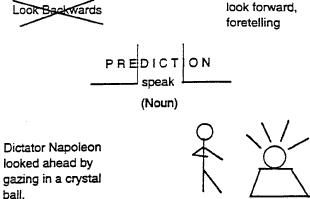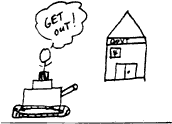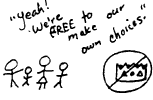| 1. Word Jar -- for independent reading
The following information is written on a strip of paper and then added to the Word Jar.
- Word
- Name of book and page number
- Sentence in which the word was used
- Dictionary definition
- Student's name
At the end of class, a word is chosen from the Word Jar and read. Students try to guess the meaning of the word (excluding the student who contributed the word). The word is then read in context, the dictionary definition is given, and the word is added to the Word Wall.
2. Vocabulary Frames
Vocabulary Frames are a flashcard method for learning new vocabulary. Do not use Vocabulary Frames for every vocabulary word encountered. Words that introduce new concepts are best used with Vocabulary Frames.

Top Right Corner: Write the word's definition
Top Left Corner: Write the word's opposite and cross it out
Lower Left Corner: Write a silly sentence that uses the definition of the word
Lower Right Corner: Draw a graphic to help you visualize the concept
In the Center: Write the word
- Isolate any prefixes
Isolate the root
Note the meaning of the root
Isolate any suffixes
Label the part of speech in parenthesis
3. K.I.M. -- for vocabulary words and new ideas
Write the term or key idea (K) in the left column, the information (I) that goes along with it in the center column, and draw a picture of the idea, a memory clue, (M) in the right column.
The key idea may be a new vocabulary word, or a new concept. The information may be a definition or it may be a more technical explanation of the concept. The memory clue is a way for students to fully integrate the meaning of the key idea into their memories. By making a simple sketch that explains the key idea, students synthesize and interpret the new information, making it their own. Then, students can reference their drawings to easily remember new key ideas.
|
K - Key idea
|
I - Information
|
M - Memory Clue
|
|
1. drought
|
Little or no rain over a period of time
|
 |
|
2. coup
|
Takeover of government by military
|
 |
|
3. sovereignty
|
Political independence
|
 |
4. Vocabulary Blocks
Vocabulary Blocks work much like K.I.M. and Vocabulary Frames. Students receive a piece of paper with several blocks on it. Their vocabulary words go in the upper left corner of each block, with a short definition in the box directly below. In the upper right-hand corner goes an antonym of the vocabulary word, and in the lower right-hand corner, a drawing of the definition of the word.
I often take each student's drawings and photocopy them onto a new piece of paper, which I use to test the students. I give them their photocopied pictures with a list of the vocabulary words; students must then match each drawing with its corresponding word.
| Gaunt |
Fat |
Perseverance |
Cessation |
| Thin and bony |
 |
Persistent effort |
 |
| Tumult |
Quiet |
Solicit |
Indifference |
| Noisy commotion |
 |
To seek, to beg |
 |
|




